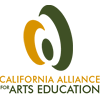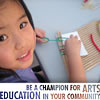Dreams of Education
Merryl Goldberg, Chair, Visual and Performing Arts Department, California State University San Marcos, and author of Arts Integration: Teaching Subject Matter Through the Arts in Multicultural Settings (Pearson, 2012, 4th edition)
I love being with my students. They exude potential, work hard in class, and have a uniquely wonderful spirit and enthusiasm for learning. They also are pretty creative when it comes to figuring out things they don’t know. For example, in the beginning of the year when I showed them pictures of musical instruments, even though they had a hard time identifying most of the instruments, they did their very best to invent ways to spell the names of instruments once we labeled them together in class. Here are a few invented spellings for instruments such as cello, cymbals, xylophone, violin, harp, saxophone, trombone, flute, guitar, oboe, timpani, and bassoon:
chellow, chelo, cielo, symbols, zilphon, xailaphone, villien, violen, arp, saxiphone, trumbone, fluit, kitour, clairanet, obo, tymphony, timponee, bazoon.
When I asked them to make a collage that portrayed arts in their lives, I first had to go over what a collage was – and show them a model. Most students had never experienced making or viewing a collage. Once they got the idea, however, they created colorful and imaginative collages using magazine pictures, photos, and images from the internet. The arts in their lives as portrayed in their delightful collages tended to focus on a few themes that surprised me: fashion, tattoos, and cars. I’ll admit my students are quite fashionable; they clearly pay attention to how they present themselves when they arrive to class. And, without a shadow of a doubt, I now understand that their depth of knowledge with regard to tattoos and cars is significant.
At this point you might be wondering about my students. It might come as a surprise that my students are in college. They are all upper division students in my class “Learning through the Arts,” designed specifically for students in a teacher credential track. These students, so capable, bright, energetic, and full of potential will become teachers in the next two years.
I am heartened that my students can see art in their everyday lives and make the connection that there are elements of art in fashion, tattoos, cars, and other areas they brought up such as bartending, make-up, and flower arranging. What strikes me, though, is that it is quite possible my students never had the experience of someone putting a paintbrush or a musical instrument in their hands, or the experience of acting or being in a dance ensemble. Their invented spellings of instruments likely indicate that they have never seen music textbooks or concert programs. Their exposure to arts as exemplified though their identification of fashion and cars could be argued to be as a result of consumer marketing as opposed to an education that included art forms. When I see my capable students, I wonder what opportunities and talent has been lost.
California State University San Marcos (CSUSM), where I have taught for over 20 years, is a federally designated Hispanic Serving Institution (HIS) as well as an Asian American Native American Pacific Islander - Serving Institution (AANAPISI). We are largely a commuter school, and the majority of our students have graduated from local school districts with partnership agreements with the University, by which students gain automatic acceptance to the University. Seventy-five percent of the local public schools in our service area Title 1 schools, and 67% of our students at the university receive financial aid. Fifty percent of students who attend the University are the first in their family to attend college.
As a result of their studies at CSUSM, many students begin to recognize what they missed, and their place in society which limited their education. “Many students’ dreams are broken by disbelief, doubt, and society,” writes one of my college students, “a society that holds back students from getting a good education because of their culture, race, color, gender, beliefs, and learning abilities. Society can be inconsiderate with students.” Though we cannot possibly make up for the lack of my current students’ access to the arts, we can make a significant contribution to these future teachers’ abilities to reach their future students. Recognizing that a full curriculum includes the arts, these future teachers can learn to open the doors that introduce children to arts and arts-based pedagogy. In so doing, they might very well be a catalyst of change within their local communities as they enter the career of teaching.
In the same Title 1 schools that my students come from, our university in partnership with the San Diego County Office of Education has initiated several research programs aimed at changing the status quo. Developing Reading Education with Arts Methods (DREAM) is one such program funded by the Department of education Office of Innovation and Improvement. DREAM trains elementary school teachers (and I literally mean our teachers are in training) to utilize theater and visual arts to teach the reading curriculum. DREAM teachers learn techniques whereby they engage students in learning to read through theater and visual arts. For example, teachers facilitate student learning through acting out scenes in stories, directing characters in context, becoming the characters in their chapter books, and through visual arts illustrating main ideas, as well as the ideas “between the lines,” or inference – one of the most interesting of all aspects of reading. Students gain insight into the skills of practice, discipline, critical thinking, and imaginative thinking. As they engage their students in these activities, teachers report being re-engaged themselves and finding joy in teaching. And, they report on the confidence they see in students and their recognition of their ability to learn deeply.
In our research, which spanned 10 school districts, students gained on average of 87 points in one year on the California Assessment Language test. Third and fourth graders consistently went from a designation of below basic to proficient. While these gains are remarkable, two things are strikingly noteworthy. First and foremost, the students were capable all along – all they and their teachers needed was the opportunity and opening to show it. Secondly, though we reached 150 teachers and 3000 students, there are 40,000 equally capable students who didn’t have the opportunity.
My student, who wrote about broken dreams, also wrote this, “Art can be used to inspire students with disbelief and doubt. Art can give a student purpose. With the help of art, students can reach great altitudes and find greatness.” I have high hopes that my students will become wonderful teachers and open the doors they recognize have been closed to them in their own education. Every child deserves the best education possible and every parent, no matter what their background and context, wants the very best for her or his children. As we begin to uncover the consequences of the last 10 – 15 years of the widening education gap, I hope we begin to bank on students’ abilities and potential by investing in arts learning and professional development and this go around: truly not leave any child behind.










